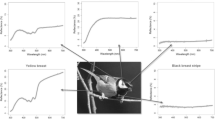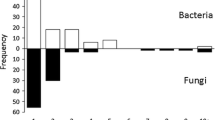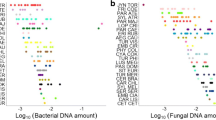Abstract
Plumage bacteria may play an important role in shaping the life histories of birds. However, few studies have examined natural patterns of variation in plumage bacteria. We have previously shown that plumage bacterial load is higher during the pre-laying period than during the brood rearing period in female Great Tits (Parus major). Here, we examined whether the pre-laying bacterial peak in female Great Tits develops during nest-building, where the females come into increased contact with the ground and nest materials, or dates back to an earlier period. Females were captured during three stages of nest-building (nest initiated, nest half ready, and nest completed). The density of plumage bacteria and the species richness of feather-degrading bacterial assemblages were studied using flow cytometry and ribosomal intergenic spacer analysis (RISA), respectively. The density of attached bacteria on feathers increased significantly between nest initiation and nest completion. No effect of nest-building stage on feather-degrading bacterial species richness was found. Our results indicate that the density of attached bacteria in the plumage of free-living birds can change rapidly during nest-building, providing one potential cost of nest-building for individual birds.
Zusammenfassung
Anstieg in der Bakterienbelastung des Gefieders während des Nestbaus bei einer Singvogelart
Gefiederbakterien spielen für Vögel möglicherweise eine bedeutende Rolle der Ausprägung ihrer Lebensgeschichte. Allerdings haben bisher wenige Studien die natürlichen Muster in der Variation von Gefiederbakterien untersucht. Wir haben bereits gezeigt, dass die Bakterienbelastung des Gefieders weiblicher Kohlmeisen (Parus major) in der Zeit vor der Eiablage höher liegt, als während der Jungenaufzucht. Hier haben wir nun untersucht, ob der Bakterien-Peak vor der Legephase bei weiblichen Kohlmeisen während des Nestbaus entsteht, bei dem die Weibchen in erhöhten Kontakt mit dem Boden und mit dem Nestmaterial kommen, oder ob er sich schon zu einer früher Zeit entwickelt. Die Weibchen wurden in drei Phasen des Nestbaus gefangen (Nest angefangen, Nest halb fertig und Nest fertiggestellt). Die Dichte an Gefiederbakterien und die Artenvielfalt Federn abbauender Bakteriengemeinschaften wurden mittels Durchflusszytometrie bzw. einer Analyse der ribosomalen intergenetischen Spacer (RISA) untersucht. Die Dichte anhaftender Bakterien auf den Federn stieg zwischen Nestanfang und -Fertigstellung signifikant an. Auf den Artenreichtum der Federn abbauenden Bakterien hatte die jeweilige Nestbauphase keinen nachweisbaren Einfluss. Unsere Ergebnisse deuten darauf hin, dass sich die Dichte anhaftender Bakterien im Gefieder freilebender Vögel während des Nestbaus schnell ändern kann, was für einzelne Vögel möglicherweise einen Teil der Nestbaukosten verursacht.

Similar content being viewed by others
References
Bisson I-A, Marra PP, Burtt EH Jr, Sikaroodi M, Gillevet PM (2007) A molecular comparison of plumage and soil bacteria across biogeographic, ecological, and taxonomic scales. Microb Ecol 54:65–81
Bisson I-A, Marra PP, Burtt EH Jr, Sikaroodi M, Gillevet PM (2009) Variation in plumage microbiota depends on season and migration. Microb Ecol 58:212–220
Broggi J, Senar JC (2009) Brighter great tit parents build bigger nests. Ibis 151:588–591
Bruce J, Drysdale EM (1994) Trans-shell transmission. In: Board RG, Fuller R (eds) Microbiology of the avian egg. Chapman and Hall, London, pp 63–91
Brush AH (1965) Energetics, temperature regulation and circulation in resting, active and defeathered California quail, Lophortyx californicus. Comp Biochem Physiol 15:399–421
Burtt EH Jr, Ichida JM (1999) Occurrence of feather-degrading bacilli in the plumage of birds. Auk 116:364–372
Burtt EH Jr, Ichida JM (2004) Gloger’s rule, feather-degrading bacteria, and color variation among song sparrows. Condor 106:681–686
Cramp S, Perrins CM (1993) The birds of the western Palearctic, vol VII. Oxford University Press, Oxford
Cristol DA, Armstrong JL, Whitaker JM, Forsyth MH (2005) Feather-degrading bacteria do not affect feathers on captive birds. Auk 122:222–230
Falcioni T, Papa S, Gasol JM (2008) Evaluating the flow-cytometric nucleic acid double-staining protocol in realistic situations of planktonic bacterial death. Appl Environ Microbiol 74:1767–1779
Gunderson AR (2008) Feather-degrading bacteria: a new frontier in avian and host-parasite research? Auk 125:972–979
Gunderson AR, Forsyth MH, Swaddle JP (2009) Evidence that plumage bacteria influence feather coloration and body condition of eastern bluebirds Sialia sialis. J Avian Biol 40:440–447
Lucas FS, Bertru G, Höfle MG (2003a) Characterization of free-living and attached bacteria in sediments colonized by Hediste diversicolor. Aquat Microb Ecol 32:165–174
Lucas FS, Broennimann O, Febbraro I, Heeb P (2003b) High diversity among feather-degrading bacteria from a dry meadow soil. Microb Ecol 45:282–290
Lucas FS, Moureau B, Jourdie V, Heeb P (2005) Brood size modifications affect plumage bacterial assemblages of European starlings. Mol Ecol 14:639–646
Mänd R, Tilgar V, Lõhmus A, Leivits A (2005) Providing nest boxes for hole-nesting birds–Does habitat matter? Biodivers Conserv 14:1823–1840
Muyzer G, De Waal EC, Uitterlinden AG (1993) Profiling of complex microbial populations by denaturing gradient gel electrophoresis analysis of polymerase chain reaction-amplified genes coding for 16S rRNA. Appl Environ Microbiol 59:695–700
Muza MM, Burtt EH Jr, Ichida JM (2000) Distribution of bacteria on feathers of some eastern North American birds. Wilson Bull 112:432–435
Peele AM, Burtt EH Jr, Schroeder MR, Greenberg RS (2009) Dark color of the coastal plain swamp sparrow (Melospiza georgiana nigrescens) may be an evolutionary response to occurrence and abundance of salt-tolerant feather-degrading bacilli in its plumage. Auk 126:531–535
Peralta-Sanchez JM, Møller AP, Martin-Platero AM, Soler JJ (2010) Number and colour composition of nest lining feathers predict eggshell bacterial community in barn swallow nests: an experimental study. Funct Ecol 24:426–433
Ranjard L, Brothier E, Nazaret S (2000a) Sequencing bands of ribosomal intergenic spacer analysis fingerprints for characterization and microscale distribution of soil bacterium populations responding to mercury spiking. Appl Environ Microbiol 66:5334–5339
Ranjard L, Poly F, Nazaret S (2000b) Monitoring complex bacterial communities using culture-independent molecular techniques: application to soil environment. Res Microbiol 151:167–177
Riffel A, Lucas F, Heeb P, Brandelli A (2003) Characterization of a new keratinolytic bacterium that completely degrades native feather keratin. Arch Microbiol 179:258–265
Saag P, Tilgar V, Mänd R, Kilgas P, Mägi M (2011) Plumage bacterial assemblages in a breeding wild passerine: relationships with ecological factors and body condition. Microb Ecol 61:740–749
Sangali S, Brandelli A (2000) Isolation and characterization of a novel feather-degrading bacterial strain. Appl Biochem Biotechnol A 87:17–24
Saranathan V, Burtt EH Jr (2007) Sunlight on feathers inhibits feather-degrading bacteria. Wilson J Ornithol 119:239–245
Selje N, Simon M (2003) Composition and dynamics of particle-associated and free-living bacterial communities in the Weser estuary, Germany. Aquat Microb Ecol 30:221–237
Shawkey MD, Pillai SR, Hill GE (2003) Chemical warfare? Effects of uropygial oil on feather-degrading bacteria. J Avian Biol 34:345–349
Shawkey MD, Mills KL, Dale C, Hill GE (2005) Microbial diversity of wild bird feathers revealed through culture-based and culture-independent techniques. Microb Ecol 50:40–47
Shawkey MD, Pillai SR, Hill GE (2009) Do feather-degrading bacteria affect sexually selected plumage color? Naturwissenschaften 96:123–128
Stach JEM, Maldonaldo LA, Masson DG, Ward AC, Goodfellow M, Bull AT (2003) Statistical approaches for estimating actinobacterial diversity in marine sediments. Appl Environ Microbiol 69:6189–6200
Swaddle JP, Witter MS, Cuthill IC, Budden A, McCowen P (1996) Plumage condition affects flight performance in common starlings: implications for developmental homeostasis, abrasion and moult. J Avian Biol 27:103–111
Tomás G, Merino S, Moreno J, Sanz JJ, Morales J, García-Fraile S (2006) Nest weight and female health in the blue tit (Cyanistes caeruleus). Auk 123:1013–1021
van Noordwijk AJ, McCleery RH, Perrins CM (1995) Selection for the timing of great tit breeding in relation to caterpillar growth and temperature. J Anim Ecol 64:451–458
Acknowledgments
We are grateful to Veljo Kisand and his co-workers from the Molecular Microbiology Group of the Institute of Technology, University of Tartu, for valuable advice and laboratory assistance and to Elo Rasmann for her help with fieldwork. We thank John Davison, Edward H Burtt Jr and an anonymous reviewer who made useful comments on the manuscript. The study was financially supported by the Estonian Science Foundation (grant number 8566), the Estonian Ministry of Education and Science (target-financing project number SF0180004s09) and the European Regional Development Fund (Center of Excellence FIBIR). The study complies with the current laws of Estonia.
Author information
Authors and Affiliations
Corresponding author
Additional information
Communicated by T. Friedl.
Rights and permissions
About this article
Cite this article
Kilgas, P., Saag, P., Mägi, M. et al. Plumage bacterial load increases during nest-building in a passerine bird. J Ornithol 153, 833–838 (2012). https://doi.org/10.1007/s10336-011-0801-3
Received:
Revised:
Accepted:
Published:
Issue Date:
DOI: https://doi.org/10.1007/s10336-011-0801-3




